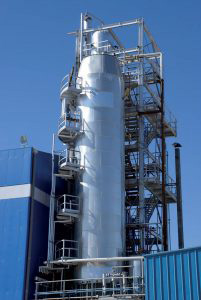Refining is intended for inedible oils such as pomace oils and lampante and other oils; In compliance with the standards of the International Olive Council and international standards, the process consists of dewaxing (winterization), neutralization, bleaching and deodorization.
The qualities obtained are refined pomace oils known as Pomace and refined lampante oils known as Olive Oil or Pure Olive Oil.
Lampante virgin olive oil is the oil obtained from the fruit of the olive tree (Oleaeuropaea L.) only by mechanical or other physical processes under conditions, particularly thermal, which do not alter the oil, and not having undergone any treatment other than washing, decantation, centrifugation and filtration, and whose physicochemical and / or organoleptic characteristics are such that it is not suitable for consumption as is.
This oil must undergo a refining process in order to make it edible without danger to health. The product obtained by refining lampante virgin olive oil and possibly other virgin olive oils is refined olive oil.
Refined olive oil must meet the purity and quality criteria set by the Olive Oil Trade Standard adopted by the International Olive Council.
Olive pomace is a by-product of the olive oil extraction process. Pomace contains a quantity of residual oil after the initial extraction phase, this amount can reach up to 4%. A second cold or chemical extraction can make it possible to obtain olive-pomace oil, which is inedible as it is. Like vegetable oils, crude pomace oil must undergo refining.
The main objective of the refining process is to make the oils suitable for consumption in accordance with the trade standard of the International Olive Council.
The product obtained by refining crude olive-pomace oil, which does not cause any change in the initial glyceric structure, is refined olive-pomace oil.
Refined olive oil and refined olive-pomace oil are intended for the food industry and packaging industries which cut or blend them with virgin olive oil specific to the consumption as is (extra virgin olive oil, virgin olive oil) to market them under the following names :
- Olive Oil (or Pure Olive Oil): blend of refined olive oil and extra virgin olive oil.
- Olive-Pomace Oil (or Pomace olive oil): blend of olive-pomace oil and extra virgin olive oil.

The moist olive pomace is received from the various oil mills and is stored in the open air on surfaces designed to avoid any pollution of the environment by filtration as well as contamination of the pomace.
⦁ Reception of lampante virgin olive oils, other virgin olive oils if applicable and crude olive-pomace oils in tanks.
⦁ Reception of technological aids: water, bleaching earths, activated carbon, amorphous silicas, filter earths, paper filters, cellulose, soda, phosphoric acid, sulfuric acid, hydrochloric acid, salt, and citric acid. All products used in the refinery must be food grade products.
Collection and storage of sealed samples of the oils received for analysis, according to ISO 5555, in order to assess their compliance with the contract and to program the refining conditions before their application.
This is an operation that involves crude oils too loaded with waxes, this is the case with olive-pomace oil.
The oils first undergo cooling which generates crystallizations and secondly a preparation which eliminates the crystals formed.
The oil enters coolers where it cools to a temperature between 4 and 7 ° C with the addition of soda.
Then, it passes through a maturator for about 8 hours with the addition of 5 to 7% water. It is then reheated between 17 and 21 ° C. The oil finally passes through a centrifuge and the waxes are drawn into the aqueous phases.
The oil is warmed to 85-90 ° C and sent to the centrifuge. Gradually, caustic soda is added, which is necessary for the neutralization of free fatty acids and which makes it possible to rid the oil of phospholipids and metallic traces. Neutralization with soda removes free fatty acids in the form of soap called soapy pastes according to the following reaction :
R-COOH (acid) + NaOH (base) R-COONa (soap) + H2O (water).
R-COONa (soap) + H2O (water).
⦁ Washing : This operation removes alkaline substances (excess soap and soda), as well as various traces of metals, phospholipids and other impurities.
⦁ Drying : This operation eliminates moisture in the washed oil before discoloration.
The purpose of this operation is to give the oil a transparent color for the lampante refined to a greenish color for the olive-pomace oil. This is a physical phenomenon : it is the absorption of dyes on bleaching earth or on activated carbon.
The operation is carried out hot, just like the previous operations and under vacuum. The oil and bleaching earth mixture is stirred in a decolorizer equipped with stirrers. This operation is followed by filtration.
Last phase of refining, it is carried out at high temperature 210 to 220 ° C and under vacuum (in the deodorization column) and must be carried out with the greatest care.
Its purpose is to remove traces of fatty acids, hexane, and insecticides and to remove flavorful and odorous substances by vacuum distillation using direct steam.
Using paper safety filters or other suitable material to remove any possible traces of bleaching earth or other impurities.